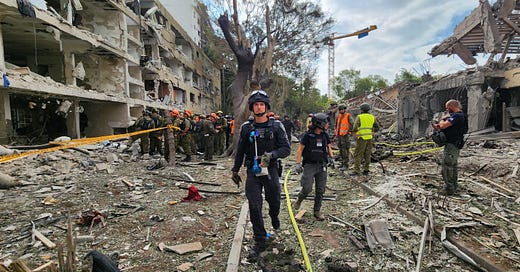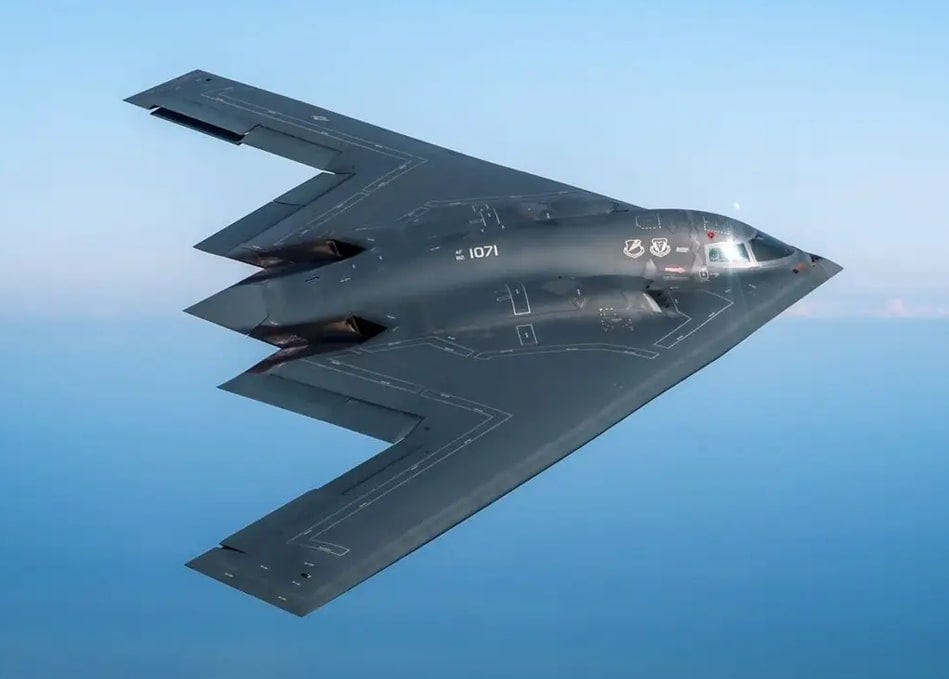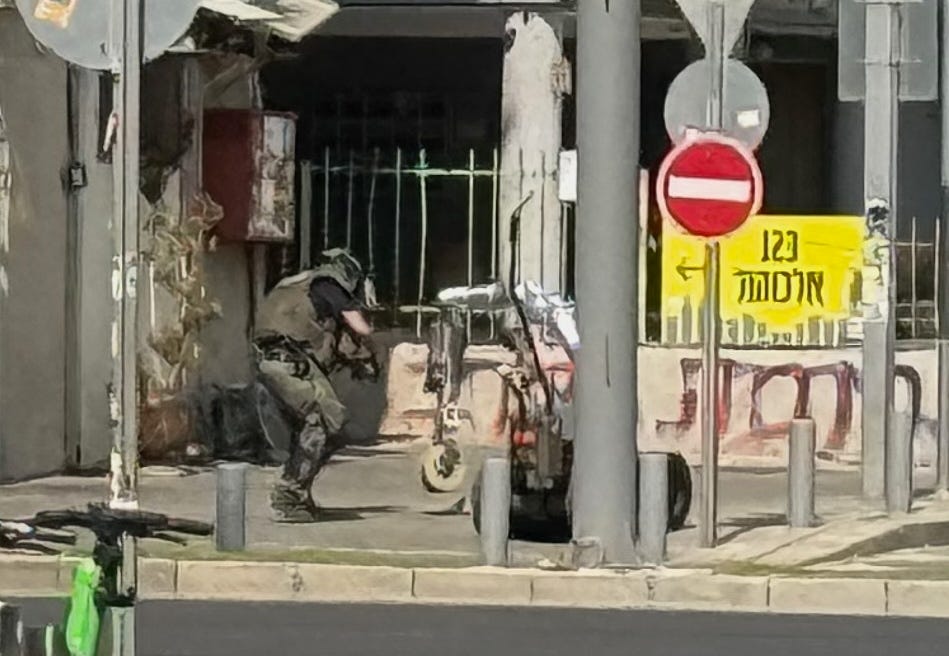DAY 10 OF THE IRAN WAR • DAY 625 OF THE WAR: U.S. Bombs Iranian Nuclear Facilities, Missiles Hit Tel Aviv and Ness Ziona, Israel Recovers Bodies of Three Former Hostages in Gaza
Tel Aviv Diary, June 22, 2025
It finally happened. I woke up this morning to the stunning news that the United States launched strikes on nuclear sites in Iran overnight. For days, Israeli media had been reporting that American B-2 bombers were departing their bases in Missouri and heading west—supposedly bound for Guam. Many of us dismissed the reports, assuming the aircraft were simply being repositioned in case of future action. As it turns out, that narrative was an elaborate ruse.
At the same time the widely reported group of B-2 bombers was heading westward, another formation— this one comprised of seven B-2s—quietly took off from the United States, and flew east across the Atlantic, bound for the Mediterranean. Their flight went undetected by any radar systems. Designed for precisely this purpose, the B-2 stealth bomber is engineered to evade radar—and in this case, it did so flawlessly. In total, 125 U.S. aircraft took part in the operation, including aerial refueling tankers, advanced fighter jets, and intelligence-gathering planes, forming a formidable aerial armada en route to Iran.
Prior to the arrival of the B-2 bombers, U.S. fighter jets moved in to neutralize potential threats and clear the airspace. Once the area was secured, the B-2s reached their primary target: Iran’s Fordow nuclear facility, a heavily fortified uranium enrichment site buried deep beneath a mountain. Each bomber deployed a GBU-57 Massive Ordnance Penetrator, a weapon specifically engineered to pierce hardened underground targets—in this case, a mountain. According to the U.S. Air Force, all bombs struck their designated targets with precision.
The full extent of the damage is not yet known, as the Bomb Damage Assessment (BDA) is still ongoing. What is evident, however, is that two secondary targets—the Natanz facility, previously struck by Israel, and another strike in Isfahan, a site believed to house enriched uranium—were successfully hit by submarine-launched Tomahawk missiles. Reports suggest that the Natanz complex was completely destroyed following the detonation of two additional large bombs dropped on the site.
It may take days or even weeks before the scope of the strike on Fordow becomes known. Given the facility’s fortified location deep beneath a mountain, and Iran’s tight control over information, the true impact may never be publicly confirmed—unless intelligence sources manage to obtain internal reports.
While the US operation was tactically very impressive, it was made possible in large part by the Israeli Air Force, which had already eliminated Iran’s air defense systems, clearing the path for the American strike force.
As news broke of the U.S. strike on Iran, Israel’s Home Front Command swiftly reinstated its most stringent emergency protocols. Only essential workers were permitted to report to duty, and the country’s airspace was once again shut down. The widespread assumption was that a large-scale Iranian missile retaliation was imminent.
I stepped outside briefly to walk Milo, intending to stay close to home. We had barely reached a small park just a block and a half away when an alert flashed on my phone: a missile attack was incoming.
We rushed back home and made it into our building’s bomb shelter even before everyone else in our building. Moments later, Iran launched two staggered barrages of missiles. We heard one explosion echo in the distance—it was later confirmed to have struck in northern Tel Aviv, in the original section of Ramat Aviv dating back to the early 1950s. While much of that neighborhood has since been rebuilt with modern high-rises, the area hit includes older residential buildings and sits not far from the Tel Aviv University campus.
The impact in Ramat Aviv caused extensive damage. Facades of several buildings were blown out, and one main structure—already vacated and slated for demolition as part of an urban renewal project—was partially destroyed by the blast, ironically accelerating its removal and saving on demolition costs. Still, many surrounding buildings suffered serious damage, forcing residents to evacuate. A nearby shopping center, home to bakeries and local stores, was also hit hard, sustaining significant structural harm.
A second missile struck the southern Tel Aviv suburb of Ness Ziona, landing directly on a private home and reducing it to rubble. Fortunately, the occupants had taken shelter in time and sustained only minor injuries. This blast also occurred near a nursing home, but residents were already in protected areas; a few suffered light injuries from the shockwave.
In Haifa, an explosion occurred after an Israeli interceptor veered off course, resulting in several injuries.
A separate incident occurred just outside our home, where we noticed police officers gathering near our building. Stepping outside, we learned that a cluster warhead—believed to be of Iranian origin—had landed on the corner across the street. Police quickly cordoned off the area, while specialized bomb disposal teams arrived on the scene to examine the explosive. Using a robotic arm, the unit carefully secured the warhead and loaded it into a specialized transport vehicle. The operation took nearly two hours, underscoring the increasingly varied tactics Iran is using in its attacks.
In total, Iran launched 25 missiles at Israel this morning. However, the original assault was intended to be far more extensive. A significant number of missiles were intercepted and destroyed by Israeli Air Force jets during the launch phase, greatly limiting the scale of the onslaught.
What does this mean for the road forward? Several critical factors must now be considered. Chief among them is President Trump’s unequivocal demand: the only acceptable outcome is a complete halt to Iran’s uranium enrichment program. The key question is whether the Iranian regime can accept such terms. While doing so would be represent a major concession—undermining both national pride and long-standing strategic ambitions—it would not be without precedent.
During the Iran-Iraq War, Teheran ultimately accepted a ceasefire it had long resisted, driven largely by the relentless barrage of Iraqi missile strikes on Iranian cities. Could similar pressure compel Iran to back down now? That remains uncertain.
Were Henry Kissinger still alive and engaged, one might imagine him engineering a diplomatic off-ramp—a face-saving solution that would allow Teheran to de-escalate without appearing to surrender. Today, however, it is far from clear whether any diplomat has the stature or strategic finesse to broker such an agreement.
Realistically, a negotiated agreement may be the only viable path to resolving this standoff— short of the far less likely prospect of regime change. While regime change remains a powerful and often appealing idea in the West, it ultimately hinges on the Iranian people rising up to reclaim their future—something they have so far not done in any meaningful or sustained way.
One final point: the precise moment President Trump decided to authorize the strike remains unknown. However, it appears that by Friday, Trump had concluded that the Iranians were unwilling to adjust their stance in any substantial way. That assessment likely led him to determine that diplomacy had reached a dead end—prompting him to approve the military action that followed soon after.
The question on everyone’s mind is whether—and how—Iran will respond. At this stage, any prediction would be pure speculation, and I see little value in adding to the guesswork.
LEGALITY OF THE U.S. STRIKE ON IRAN
During today’s Zoom session, someone submitted a question in the chat regarding the legality of the U.S. attack on Iranian nuclear facilities—an important issue I didn’t see until after the session ended. The question raises a long-standing constitutional debate over the division of war powers between Congress and the executive branch.
The U.S. Constitution grants Congress the sole authority to declare war, and for over a century that process was observed. Every American war up to and including World War II was formally declared by Congress. Yet, U.S. history is replete with examples of presidents initiating military action without such declarations—from the campaign against Tripolitan pirates in the early 1800s to repeated interventions in Nicaragua and several parts of Central and South America during the early 20th century.
The constitutional ambiguity stems from two competing provisions: while only Congress possesses the authority to declare war, the President is designated as commander-in-chief of the armed forces. The boundary between these roles remains blurry.
This tension reached a breaking point during the Vietnam War, prompting the passage of the War Powers Act in 1973. The legislation was designed to rein in presidential authority by requiring the president to notify Congress within 72 hours of deploying troops into situations where hostilities are imminent. It also mandates ongoing updates to lawmakers throughout the course of any such engagement.
According to Defense Secretary Pete Hegseth, the administration formally notified Congress in accordance with the War Powers Act once U.S. aircraft had exited Iranian airspace following the strike. As such, while the President retains the authority to initiate limited military operations under his role as Commander-in-Chief, launching a full-scale war would still require explicit congressional authorization.
Meanwhile, on the home front, the ongoing war has rendered 11,000 Israelis homeless— residents whose apartments have been either completely destroyed or so severely damaged that repairs could take months. Fortunately, the downturn in tourism has freed up hotel rooms for temporary housing. Still, the financial responsibility for accommodating these displaced individuals falls squarely on the Israeli government.
Complicating matters further, today’s U.S. strike on Iran disrupted efforts to repatriate Israelis stranded abroad. Originally, a total of 24 return flights had been scheduled, but with Israeli airspace closed until 2 p.m., only 10 landed at Ben Gurion Airport and five at Haifa—down from the planned nine. While the number of flights is expected to increase tomorrow, ground operations at the airports will remain tightly restricted to minimize the risk of damage from possible missile strikes.
During today’s Zoom session, someone also asked when Ben Gurion Airport might resume normal operations. My response was blunt: not until the war ends. The risk posed by even a single missile strike near the terminal is too great to allow full commercial activity to resume.
For now, limited outbound travel will be permitted starting tomorrow—but under strict conditions. Flights will be capped at 50 passengers each, and all travelers must commit to remaining abroad for a minimum of 30 days.
PRESIDENT TRUMP’S STATEMENT TO AMERICANS
President Trump addressed the nation last night following the U.S. strike on Iranian nuclear facilities. Here is the text of his statement:
A short time ago, the US military carried out massive, precision strikes on the three key nuclear facilities in the Iranian regime. Fordo, Natanz and Isfahan. Everybody heard those names for years as they built this horribly destructive enterprise.
Our objective was the destruction of Iran’s nuclear enrichment capacity and a stop to the nuclear threat posed by the world’s number one state sponsor of terror.
Tonight, I can report to the world that the strikes were a spectacular military success. Iran’s key nuclear enrichment facilities have been completely and totally obliterated. Iran, the bully of the Middle East, must now make peace. If they do not. Future attacks would be far greater and a lot easier.
For 40 years, Iran has been saying. Death to America, death to Israel. They have been killing our people, blowing off their arms, blowing off their legs, with roadside bombs. That was their specialty. We lost over 1,000 people and hundreds of thousands throughout the Middle East, and around the world have died as a direct result of their hate in particular. So many were killed by their general, Qassim Soleimani. I decided a long time ago that I would not let this happen. It will not continue.
US President Donald Trump pumps his fist as he boards Air Force One at Morristown Municipal Airport in Morristown, New Jersey, on June 21, 2025, as he returns to the White House from his golf club in Bedminster, New Jersey. (Mandel Ngan/AFP) I want to thank and congratulate Prime Minister Bibi Netanyahu. We worked as a team like perhaps no team has ever worked before, and we’ve gone a long way to erasing this horrible threat to Israel. I want to thank the Israeli military for the wonderful job they’ve done.
And most importantly, I want to congratulate the great American patriots who flew those magnificent machines tonight, and all of the United States military on an operation the likes of which the world has not seen in many, many decades.
Iran’s key nuclear enrichment facilities have been completely and totally obliterated.
Hopefully, we will no longer need their services in this capacity. I hope that’s so. I also want to congratulate the chairman of the Joint Chiefs of Staff, General Dan ‘Razin’ Caine, spectacular general, and all of the brilliant military minds involved in this attack.
With all of that being said, this cannot continue. There will be either peace, or there will be tragedy for Iran, far greater than we have witnessed over the last eight days. Remember, there are many targets left. Tonight’s was the most difficult of them all, by far, and perhaps the most lethal. But if peace does not come quickly, we will go after those other targets with precision, speed and skill. Most of them can be taken out in a matter of minutes. There’s no military in the world that could have done what we did tonight. Not even close. There has never been a military that could do what took place just a little while ago.
Tomorrow, General Caine, Secretary of Defense Pete Hegseth, will have a press conference at 8 a.m. at the Pentagon. And I want to just thank everybody. And, in particular, God. I want to just say, we love you, God, and we love our great military. Protect them. God bless the Middle East. God bless Israel and God bless America. Thank you very much. Thank you.
HOSTAGES
The Israel Defense Forces announced Sunday that they had recovered the bodies of three hostages from the Gaza Strip: Yonatan Samerano, Shay Levinson, and Ofra Keidar—all of whom had been held in Hamas captivity since the October 7 massacre.
Ofra Keidar (71), a mother of three, was brutally murdered alongside her husband, Sami, during the Hamas assault on Kibbutz Be’eri. Her body was taken into Gaza, and her death was confirmed in December 2023.
Yonatan Samerano (21), had been attending the Nova Music Festival at Re’im and fled to Kibbutz Be’eri to escape the attack. Samerano was murdered there and his body abducted to Gaza.
Shay Levinson, (19) a tank commander in the 77th “Oz” Battalion of the IDF’s 7th Armored Brigade, was also killed during the October 7 assault, though his death was only formally confirmed in January 2024.
The recovery of their remains marks another painful milestone in Israel’s ongoing efforts to locate and return the victims of Hamas’s brutal October 7 rampage.
Today’s Zoom
BUSINESS
Visby
Medical Secures Major Funding to Revolutionize At-Home STI Testing
Visby Medical, the innovative healthcare company founded by Israeli professor Adam de la Zerda, has successfully raised approximately $55 million in its latest funding round, with potential to reach $65 million. Led by Catalio Capital Management and supported by notable investors including ND Capital, Cedars Sinai Medical Center, and Pitango Ventures, this investment brings the company's total funding to $487 million. The startup has developed groundbreaking rapid PCR test kits that enable at-home detection of sexually transmitted infections, specifically targeting women's health needs with lab-quality accuracy that can be accessed from the comfort of one's home.
The company's flagship "At-Home Women's Health Test" represents a significant breakthrough in healthcare accessibility, offering the first single-use PCR diagnostic that delivers results in just 30 minutes through a smartphone-connected app. With recent FDA approval secured, the product will launch in July 2025 through direct-to-consumer channels, allowing users to bypass traditional lab visits while maintaining clinical-grade testing standards. When positive results are detected, the platform seamlessly connects users with tele-health providers for immediate consultation and treatment, creating an integrated healthcare solution that prioritizes both convenience and privacy. The funding will accelerate the product's market launch and distribution, with plans to expand internationally, including an anticipated arrival in Israel by 2026.








Appreciate the update and info on when presidents have committed military without Congress approval.
I’m thinking the time Obama killed Osama bin Laden was not that different than what happened yesterday in terms of congressional approval, not being gotten